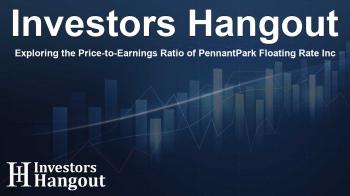Exploring the Price-to-Earnings Ratio of PennantPark Floating Rate Inc

Understanding the Price-to-Earnings Ratio
In today's stock market, investors are increasingly cognizant of how crucial metrics like the price-to-earnings (P/E) ratio can signify the potential for a stock's growth. For investors eyeing companies such as PennantPark Floating Rate Inc. (NYSE: PFLT), the current stock price sits at $10.23, reflecting a minor decrease of 0.01% in today's session. However, looking back over a month, we see this stock has experienced a decline of approximately 4.40%. Moreover, over the previous year, the overall drop amounts to around 7.77%. Such trends compel shareholders to take note of the company's P/E ratio, a significant indicator of its financial health and market expectations.
What the P/E Ratio Reveals
The P/E ratio provides insight into how much investors are willing to pay for each dollar of earnings. This ratio can hint at how a company is classified within its industry and the market at large. For example, the aggregate P/E ratio in the Capital Markets industry stands at 18.99, while PennantPark Floating Rate Inc. boasts a notably lower P/E ratio of 12.48. Such data suggests that investors might believe the stock could perform less favorably compared to its industry counterparts. Additionally, this lower ratio might reflect undervaluation, suggesting an intriguing opportunity for investors.
Comparison With Industry Standards
When assessing the P/E ratio of PennantPark Floating Rate Inc. against competitors, it’s essential to recognize the implications. A lower P/E ratio does not always imply poor performance or bleak future prospects. Instead, it sometimes indicates that a company may have the potential to deliver better value or growth returns over time. This perspective can be appealing for potential investors noticing the stock's current undervaluation.
Limitations of the P/E Ratio
While the P/E ratio serves as a vital tool for evaluation, relying solely on this metric may lead to oversights. Investors are encouraged to consider other elements such as industry trends, competitive positioning, and economic conditions, as these factors greatly influence a stock's price. In particular, the performance expectations surrounding dividends can significantly affect how investors perceive potential growth.
Understanding Market Trends
Investor sentiment encompasses many aspects, including market trends and economic forecasts. A P/E ratio that is lower relative to industry standards does not unequivocally mean the company is lacking in potential; it often leads investors to speculate on future earnings trends. This aspect is crucial for long-term investors who might be betting on a rebound or growth in the price of PFLT shares.
The Bigger Picture
The analysis of PennantPark Floating Rate Inc.'s price-to-earnings ratio offers more than just rudimentary calculations; it provides a window into the larger conversation about the company's potential. As the market remains volatile, investors must consider various financial metrics alongside qualitative insights to maximize their investment strategies. For PFLT, the current stock position and P/E ratio excite discussions about where the company may be headed.
Frequently Asked Questions
What does the P/E ratio indicate for a company?
The P/E ratio measures the company's current share price in relation to its earnings per share, indicating how much investors are willing to pay for a dollar of earnings.
How does PennantPark's P/E ratio compare to the industry?
PennantPark Floating Rate Inc. has a P/E ratio of 12.48, which is lower than the industry average of 18.99, potentially indicating undervaluation.
Why is a lower P/E ratio not always detrimental?
A lower P/E ratio can suggest undervaluation or indicate market skepticism about future growth, but it doesn't inherently mean the company will perform poorly.
What factors should be considered alongside the P/E ratio?
Investors should also consider industry trends, competitive dynamics, economic conditions, and potential dividend growth to understand a company's prospects better.
Is it wise to rely solely on the P/E ratio for investing decisions?
Relying solely on the P/E ratio could result in an incomplete analysis; it's essential to incorporate other financial metrics and qualitative insights for informed decisions.
About The Author
Contact Hannah Lewis privately here. Or send an email with ATTN: Hannah Lewis as the subject to contact@investorshangout.com.
About Investors Hangout
Investors Hangout is a leading online stock forum for financial discussion and learning, offering a wide range of free tools and resources. It draws in traders of all levels, who exchange market knowledge, investigate trading tactics, and keep an eye on industry developments in real time. Featuring financial articles, stock message boards, quotes, charts, company profiles, and live news updates. Through cooperative learning and a wealth of informational resources, it helps users from novices creating their first portfolios to experts honing their techniques. Join Investors Hangout today: https://investorshangout.com/
The content of this article is based on factual, publicly available information and does not represent legal, financial, or investment advice. Investors Hangout does not offer financial advice, and the author is not a licensed financial advisor. Consult a qualified advisor before making any financial or investment decisions based on this article. This article should not be considered advice to purchase, sell, or hold any securities or other investments. If any of the material provided here is inaccurate, please contact us for corrections.

